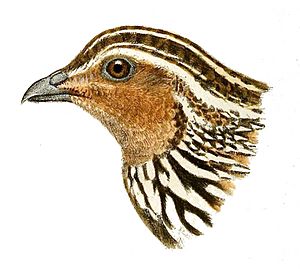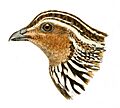Stubble quail facts for kids
The stubble quail (Coturnix pectoralis) is a small bird native to Australia. It is the most common type of quail found there. You can find stubble quails in all Australian states and territories, except for Tasmania. People sometimes call them the grey quail or the pectoral quail. This bird is not in danger of disappearing.
Contents
Classifying the Stubble Quail
The stubble quail belongs to a bird family called Phasianidae. This family includes many ground-dwelling birds like pheasants and partridges.
For a while, scientists thought the stubble quail might be the same species as the New Zealand quail, which is now extinct. However, studies in 2009 showed they are actually two different species. They became separate because the Tasman Sea grew too wide for the birds to fly across. This separation led to each group changing over time, becoming unique species.
What Does the Stubble Quail Look Like?
The stubble quail is a bird that lives on the ground. It has dark brown feathers with a cream-colored stripe down the middle of each feather. This creates stripes along its body. It's a plump bird, bigger than other native quails.
Male stubble quails grow to be about 18 to 18.5 centimeters long. Females are usually a little bit larger. Adult males weigh around 100 grams, and females weigh about 110 grams. All stubble quails have a wingspan of 25 to 33 centimeters. When they fly away quickly from the ground, their wings make a loud whirring sound. This sound helps to identify them.
How to Tell Stubble Quails Apart
Several other birds look similar to the stubble quail.
- The brown quail is also in the Phasianidae family. It looks darker than the stubble quail. The white stripes on the stubble quail's back are thinner and harder to see on the brown quail. Also, the brown quail has black stripes under its body, not white streaks like the stubble quail. When a brown quail flies, its wings make a whistling sound, which is different from the stubble quail's whirring sound.
- The plains-wanderer is a very rare bird that looks much like the stubble quail. You can tell it apart by its long yellow legs, which you can see when it flies.
- The little buttonquail is a smaller bird with short, round wings. It often makes an alarm call when it flies away, but stubble quails are usually quiet when they take off.
Where Stubble Quails Live
Stubble quails live in many different places across Australia. They can be found in very dry areas and even in high mountain grasslands. They are more common in places with a lot of rain, like southeastern and western Australia. However, you might also find them in dry areas after heavy rainfall.
They used to live in Tasmania until the 1940s to 1960s, when they disappeared from the island. On the mainland, stubble quails live in various environments. They tend to avoid forests because trees block the thick grassy areas they prefer.
These quails like tall grasslands, whether they are native grasses, introduced plants, or crops. The thickness of the ground cover is very important to them. They prefer very dense plants. If there are too many kangaroos or rabbits (or other grazing animals) in an area, they can eat down the grass. This makes the habitat unsuitable for stubble quails. You often find these birds in farm fields after crops like wheat have been harvested. They eat leftover grains and insects there.
Stubble Quail Behavior
Reproduction and Life Cycle
In Victoria, stubble quails usually breed between August and December. However, their breeding season can change depending on the weather and environment. A pair of quails might stay together all year. If they get separated, they will call to each other to find their way back.
The female stubble quail lays about seven or eight yellow eggs. She sits on the eggs to keep them warm, a process called incubation, for 18 days. Sometimes, stubble quails build their nests in crops that are about to be harvested, which can lead to their nests being destroyed. Both parents protect the chicks until they are almost fully grown. Once the chicks are about six weeks old and have all their feathers, their parents send them off to find their own homes. Male quails call at dawn and dusk to mark their territory.
How Stubble Quails Travel
Stubble quails are nomadic, meaning they move around to find food and water. If resources are very scarce, they might scatter in all directions. These birds can travel very long distances. The longest recorded journey was 1142 kilometers!
You usually see stubble quails alone or in pairs. Sometimes, you might see them in small groups of up to 20 birds. Larger groups gather in places where conditions are very good, with plenty of food and shelter.
Threats to Stubble Quails
Foxes and cats are the biggest dangers to stubble quails, especially when they are nesting. Humans also hunt stubble quails legally in some parts of Australia. However, there are strict rules to make sure they are not hunted when their population is weak. This includes times like breeding season, when they are shedding feathers, or during environmental stress.
How Stubble Quails Have Adapted
The stubble quail has developed many special features that help it live in very dry places. These include needing very little water each day. They can also handle salty water and produce very concentrated waste. This is possible because they have a large part of their kidney called the medulla, which helps them save water. If they eat green plants along with grain, stubble quails can survive without drinking any water at all.
In very hot areas, stubble quails have been seen looking for food at night. Stubble quails living in dry regions might have irregular breeding patterns. Their breeding depends more on the environment than on the length of the day. This helps them make the most of resources like food and water for their chicks. Stubble quails are most comfortable between 30 and 35 degrees Celsius. In some places where temperatures drop below freezing, they have to use a lot of energy to keep their bodies warm.
Images for kids
See also
 In Spanish: Coturnix pectoralis para niños
In Spanish: Coturnix pectoralis para niños





